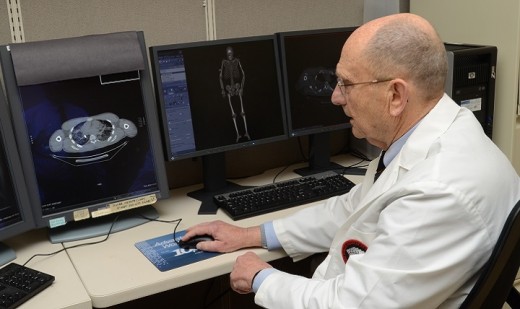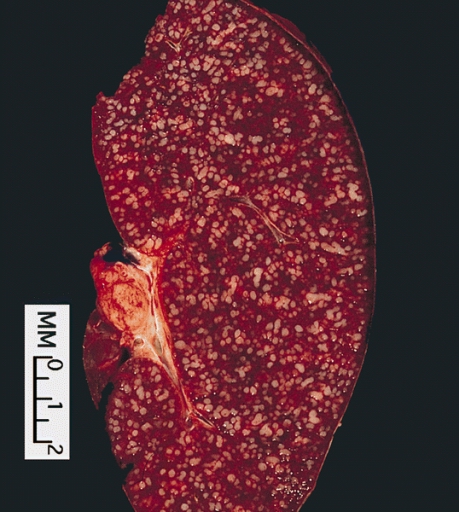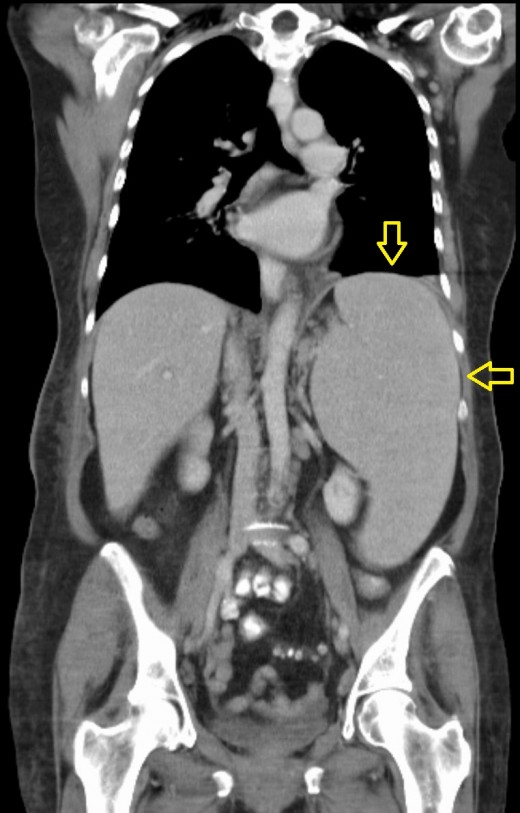Enlarged Spleen and Cancer

The spleen is an essential organ that plays a crucial role in the defense immune system.
It's located in the left upper part of the abdominal cavity, just below the diaphragm, behind the stomach, and above the left kidney.
It is considered as a part of the lymphoid system, which primarily acts as a scavenger of bacteria from the blood, since it’s very rich in cells that are specialized in engulfing and killing bacteria, that are responsible for serious infections.
If the spleen is surgically removed, for any reason, a patient should be immunized against certain types of bacteria like pneumococci and meningococci, ideally before the operation by few weeks, or to be treated with in antibiotic for the rest of his/her life, to help preventing infections cause by these species of bacteria.
How to detect an enlarged spleen?
The normal size of the spleen is 11 cm (4.3 inches) in its long axis, and it weighs about 150 grams (5.3 oz).
A large spleen usually doesn’t cause any symptoms, but if it reaches a significantly large size, there may be dull type of pain or aches in the left upper abdomen.
Sometimes, it attains a very huge size that can cause distention of the abdomen, and, by its compressing effect on the stomach, it causes a feeling of early satiety.
In the majority of patients who have enlarged spleen, the organ is only first detected either by an imaging study, like ultrasound examination, or when a doctor feels the edge of the enlarged spleen by hands, during physical examination.
A spleen affected by lymphoma

Relation between enlarged spleen and cancer:
If we take into consideration the total number of patients with enlarged spleen; cancer is responsible for only a minority of them.
The main causes of large spleen are infections, like malaria, or chronic liver disease (liver cirrhosis).
There are hundreds of causes of large spleen including some types of cancers.
Cancers that can cause enlargement of the spleen:
Blood disorders:
Since the spleen is a part of the lymphatic system, it’s affected by diseases of the lymphatic cells and other blood cells that are present in abundance within the spleen tissue.
Chronic myelogenous leukemia, which is a type of slowly progressing malignant blood disorder, is a good example of a cancer with a characteristic splenic enlargement that can be so massive.
In other types of leukemia (blood cancers), which are many, the spleen can be large, but not as huge as in chronic myelogenous leukemia.
Another group of malignant disorders of the lymphatic system is called lymphomas. Lymphomas are so diverse in their features, and they are difficult to be satisfactorily classified. In fact, the classification of lymphomas is the most complex in medicine.
Hodgkin’s disease is an example of lymphoma with a frequently enlarged spleen. Besides leukemias and lymphomas, there are less common cancerous blood disorders, which manifest with enlarged spleen as a part of the disease.
In general, there is no correlation between the size of the spleen and the severity of the underlying disease. In other words, only a mildly enlarged spleen, may be found with a severe disease, and vice versa.
But in certain blood disorders, particularly chronic myelogenous leukemia, a massively enlarged spleen is indicative of advanced disease.
An enlarged spleen shown by Magnetic Resonance Imaging (Arrows)

Common cancers and enlarged spleen:
If we exclude blood cancers as the main group of cancers causing the spleen to enlarge, there are less number of patients who suffer from other cancers, and they have huge spleen as well.
Unlike malignant diseases of the blood, other types of cancers manifest with spleen enlargement as a result of invading the organ by malignant cells that migrate from the original site of cancer, to the spleen, to grow there, and to form a mass. The spleen size subsequently, and gradually increases.
This process is not common, but it occurs in few patients who have the following types of cancers:
- Skin cancer (e.g. melanoma) : the most common
- Breast cancer
- Lung cancer
- Ovarian cancer
- Stomach cancer
Since an enlarged spleen caused by the above mentioned variable types of cancer is not common, it is more likely for a patient with enlarged spleen to have another disease, e.g. malignant blood disorder, infection, or liver disease, rather than any of the above listed.
In a less common example, the spleen may enlarge when there is a blood clot occluding the splenic vein (the vein that drains blood from the spleen). This unusual formation of blood clot in this vein can signal the presence of a hidden disease , occasionally a cancer.
How to know if an enlarged spleen indicates the presence of cancer?
If someone is found to have enlarged spleen, either by a routine medical checkup or because it causes symptoms, a series of blood tests, imaging studies, and sometimes endoscopy, should be ordered by the physician, looking for other features that may be pointing to any of the diseases causing spleen enlargement.
If, for example, there is no evidence of infection or chronic liver disease, other tests are indicated searching for any blood disorder, particularly leukemia or lymphoma.
In many instances, patients with leukemia or lymphoma have these three characteristic abnormalities:
1- Decreased immunity: evidence of recurrent infections ( for example respiratory tract, or skin infections). The cause for decreased immunity is abnormal function and/or abnormal number of immune cells.
2- Decreased blood coagulation: this means the blood is abnormally thin and a clot doesn’t form easily, thus bleeding when occurs, is prolonged. It is usually a result of low platelet count.
3- Anemia: leukemias or lymphomas may badly affect red blood cells production in the bone marrow, causing severe symptomatic anemia. Patients will get pale, and extremely exhausted, and they usually feel weak and short of breath on minimal physical exertion.
Any patient with enlarged spleen with none of the above three features present, the cause is mostly not related to cancer.
Diseases with enlarged spleen, in which the risk of future cancer is high:
Worldwide, some chronic infections, and chronic diseases of the liver , particularly liver cirrhosis (or fibrosis) , are the most common causes on increased spleen size.
Liver cirrhosis, whether it’s caused by hepatitis virus B or C infection, genetic disease, a fatty liver, or even if there is no obvious cause; carries a high risk of developing cancer within its fibrotic tissue.
Meanwhile, and because of impedance of blood flow through the cirrhotic liver, a back pressure on the spleen occurs, and the spleen gets enlarged by time.
This means, liver cirrhosis, as a common cause of large spleen, is also an important risk factor for developing liver cancer.
The diagnosis of liver cirrhosis is usually made long before cancer is diagnosed.
Conclusion:
· The most common conditions worldwide causing large spleen are chronic infections (e.g. malaria), and chronic liver disease.
· The most common cancers causing large spleen are malignant blood diseases (leukemia and lymphoma).
· If malignant blood disorders are excluded, the probability of cancer in a patient with large spleen is very low.
© 2017 Abdelhakim Elbarsha








